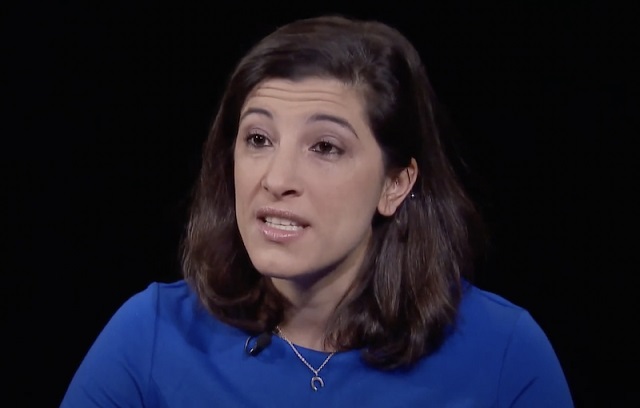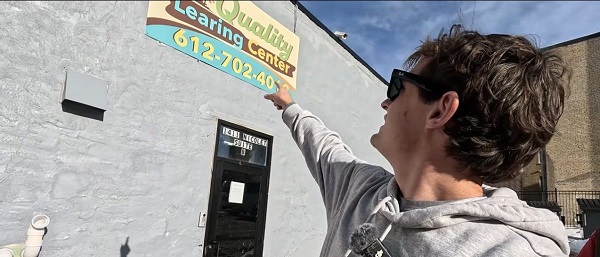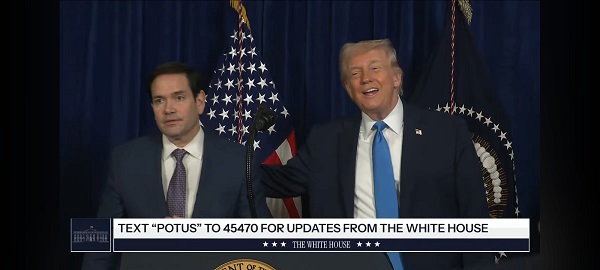Business
How the Deep State is using the ‘Censorship Industrial Complex’ to crush free speech

Renée DiResta is the research director of the Stanford Internet Observatory (SIO)
From LifeSiteNews
The Censorship Industrial Complex, dominated by organizations often run by ex-CIA agents, is working around the First Amendment to suppress dissent and promote a one-world government
Author and reformed climate activist Michael Shellenberger has coined the term “Censorship Industrial Complex,” an apparent reference to President Dwight D. Eisenhower’s Farewell Address in 1961, where the former Army General warned about the influence of the “military-industrial complex.”
In a recently published article, Dr. Joseph Mercola explored the Censorship Industrial Complex, how it works, and who some of the protagonists are. We will examine the following points regarding this nefarious network to understand how the censorship apparatus works:
- A key figure: Renée DiResta
- The Election Integrity Partnership and Virality Project
- The Council on Foreign Relations and the One World Government
- NewsGuard and the “middleware” approach
A key figure: Renée DiResta
Renée DiResta is the research director of the Stanford Internet Observatory (SIO). Mercola fittingly described the organization’s purpose: “[Founded] in June 2019,” the SIO “promote[s] internet censorship policies and conduct[s] real-time social media narrative monitoring.”
DiResta quickly climbed the career ladder despite being involved in a major election manipulation scandal. She previously worked for the CIA and is a member of the influential Council on Foreign Relations (CFR).
DiResta is a prominent example of the connections between the intelligence agency and the censorship industry, but she is certainly not the only one. The organizations that are deciding what is deemed “misinformation” or “hate speech” (i.e., the Censorship Industrial Complex) are often run by former CIA agents. According to Shellenberger’s research, seven former CIA executives serve on the board of the Atlantic Council, an organization partnered with the SIO through several projects.
“The Chief Strategy Officer and the Director of Federal Programs at Graphika, another DiResta partner organization, are former CIA officials,” Shellenberger writes.
In 2018, DiResta organized a false flag online operation that influenced an Alabama Senate race. Before she worked at the SIO, DiResta was the research director at a small political consultant firm, New Knowledge LLC, which received $100,000 from Reid Hoffman, founder of LinkedIn, to help the Democrat candidate win the U.S. Senate race in Alabama. New Knowledge used that money to subscribe thousands of fake Russian bot accounts to Republican candidate Roy Moore’s social media campaign. Mainstream media reports at the time claimed Moore was “backed by Russia,” even though his “Russian backers” were fake accounts created by New Knowledge. Moore’s Democratic opponent, Doug Jones, went on to win the race by a slim margin.
After the election, an internal report from New Knowledge, which detailed the Russian bot operation, was obtained by The New York Times. The report admits that: “We orchestrated an elaborate ‘false flag’ operation that planted the idea that the Moore campaign was amplified on social media by a Russian botnet.”
This revelation gained national media attention and was so scandalous that even members of the Atlantic Council (an organization that now collaborates with DiResta) publicly criticized this egregious example of election interference by New Knowledge.
“Somehow, DiResta survived this scandal and continues to be a leading spokesperson AGAINST disinformation and FOR election integrity, even though New Knowledge was caught red-handed using disinformation to interfere in a U.S. election,” Mercola writes.
Shellenberger said the reason that DiResta was made “the leader of the Censorship Industrial Complex,” next to her intellect and articulateness, is that “[l]ike other American elites, DiResta believes that it is the role of people like her to control what information the public is allowed to consume, lest they elect a populist ogre like Donald Trump, decide not to get vaccinated, or don’t accept whatever happens to be mainstream liberal opinion on everything from climate change to transgenderism to the business dealings of the president[‘s] family.”
The Election Integrity Partnership and Virality Project
The Election Integrity Partnership (EIP) was founded only months before the 2020 U.S. presidential election “to defend our elections against those who seek to undermine them by exploiting weaknesses in the online information environment.”
Mike Benz, former State Department official in the Trump administration and executive director for the Foundation for Freedom Online, explained in a video that EIP was created as a “government cut-out,” a “private” organization that de facto acts as censorship arm for the things the government cannot censor because it lacks the legal authority to do so.
One of the “partners” of the EIP is DiResta’s SIO. Benz also notes that all of the EIP’s partners are at least partly funded by the government.
Elon this video goes over it in insta-PhD level detail. It shows exactly how DHS created the EIP censorship octopus. Condensed to 8 mins here: pic.twitter.com/l5EaxAIChD
— Mike Benz (@MikeBenzCyber) November 7, 2023
In May 2020, a new organization with mostly the same “partners” as the EIP was created, the Virality Project (VP). The VP focused on censoring COVID-related content online, including factual information that “might promote vaccine hesitancy.”
A spokesperson from the SIO (one of the VP’s founding partners) claimed it “did not censor or ask social media platforms to remove any social media content regarding coronavirus vaccine side effects.” Perhaps the SIO did not censor content directly, but the VP that was founded by the SIO certainly did, as the Twitter Files released by Elon Musk have shown.
According to the Twitter Files published by journalist Matt Taibbi, the VP pressured social media platforms such as Twitter (now X) and TikTok to remove or flag online content. Posts flagged by VP included:
- True information that could fuel “vaccine hesitancy”
- Posts critical of vaccine passports
- True testimonies of people experiencing blood clots after receiving COVID shots
- People asking questions about possible adverse reactions from the jabs
The Council on Foreign Relations and the One World government
As mentioned above, DiResta, in addition to being a former CIA agent, is also a member of the Council on Foreign Relations (CFR), a think tank specialized in U.S. foreign policy. The globalist CFR is partly funded by the Bill & Melinda Gates Foundation and the Rockefeller Foundation.
The CFR was founded in 1921 and has heavily influenced U.S. foreign policy ever since. Most CIA directors and U.S. secretaries of defense have been members of the Council. Mercola argues that the CFR’s ultimate goal “has been to bring about a totalitarian one world government, a New World Order (NWO) with global top-down rule.”
According to the Centre for Research on Globalization, James Warburg, the son of one of the CFR’s founders, told the Senate Foreign Relations Committee in 1950: “We shall have world government whether or not you like it – by conquest or consent.”
Moreover, CFR insider and former U.S. Navy Admiral Chester Ward stated the following in his 1975 book Kissinger on the Couch:
“[The CFR has as a goal] submergence of U.S. sovereignty and national independence into an all-powerful one-world government … This lust to surrender the sovereignty and independence of the United States is pervasive throughout most of its membership … In the entire CFR lexicon, there is no term of revulsion carrying a meaning so deep as ‘America First.’”
Mercola concludes that the Censorship Industrial Complex is part of the network that seeks to establish a one-world government.
“Those who oppose America First policies do so because they’re working on behalf of a network that seeks to eliminate nationalism in favor of a one-world government, and DiResta is part of that club,” he writes.
NewsGuard and the ‘middleware approach’
In another condensed video, Benz explains how the Censorship Industrial Complex is now using so-called “middleware” organizations like the news rating site NewsGuard to suppress dissent from the mainstream narratives.
The "Middleware" Plan To Restructure The Censorship Industry
1. Middleware = 'censorship as a service' orgs
2. Morphing from top-down to middle-out
3. Regs + middleware = disinfo compliance market pic.twitter.com/lDPqH72HrD
— Mike Benz (@MikeBenzCyber) August 1, 2023
According to Benz, the Censorship Industrial Complex is anticipating a loss in the Missouri v. Biden Supreme Court case, which “threatens to ban all government coordination of domestic censorship with a few exceptions[.]”
To circumvent these possible legal restrictions, the government is propping up “intermediary censorship mercenary firms like NewsGuard.”
READ: Elon Musk slams leftist rating group NewsGuard as ‘scam’ that ‘should be disbanded immediately’
By funding these “private” organizations, the deep state government agencies can “effectively circumvent the First Amendment prohibitions on running a comparable thing out of the DHS [Department of Homeland Security].”
However, the idea that NewsGuard is somehow independent from the government is wholly divorced from reality. In 2021, the Department of Defense awarded NewsGuard $750,000 for its project “Misinformation Fingerprints,” which aims to combat what it calls “a catalogue of known hoaxes, falsehoods and misinformation narratives that are spreading online.”
Moreover, Benz notes that NewsGuard’s Advisory Board consists of “an all-star apex predator caste of the national security state,” including
- retired Four-Star General Michael Hayden, who was formerly the head of the CIA and NSA,
- Richard Stengel, former Undersecretary of State,
- Tom Ridge, former head of the DHS,
- and Anders Fogh Rasmussen, former head of NATO.
By propping up “middleware” companies such as NewsGuard that are not technically part of the government, the Censorship Industrial Complex is able to work around possible First Amendment restrictions, as websites that receive a negative rating from NewsGuard will have reduced visibility on Big tech platforms and search engines. The negative rating by NewsGuard also provides a pretext for private Big Tech platforms to label outlets as spreaders of “misinformation” and censor them outright.
“There’s no clear solution to this threat, other than to continue pushing back against any and all efforts to legalize, standardize and normalize censorship,” Mercola writes in his conclusion. “To vocally object, to refuse using middleware like NewsGuard, and to boycott any company or organization that uses middleware or engages in censorship of any kind.”
Business
Virtue-signalling devotion to reconciliation will not end well

From the Fraser Institute
By Bruce Pardy
In September, the British Columbia Supreme Court threw private property into turmoil. Aboriginal title in Richmond, a suburb of Vancouver, is “prior and senior” to fee simple interests, the court said. That means it trumps the property you have in your house, farm or factory. If the decision holds up on appeal, it would mean private property is not secure anywhere a claim for Aboriginal title is made out.
If you thought things couldn’t get worse, you thought wrong. On Dec. 5, the B.C. Court of Appeal delivered a different kind of upheaval. Gitxaala and Ehattesaht First Nations claimed that B.C.’s mining regime was unlawful because it allowed miners to register claims on Crown land without consulting with them. In a 2-to-1 split decision, the court agreed. The mining permitting regime is inconsistent with the United Nations Declaration on the Rights of Indigenous People (UNDRIP). And B.C. legislation, the court said, has made UNDRIP the law of B.C.
UNDRIP is a declaration of the United Nations General Assembly. It consists of pages and pages of Indigenous rights and entitlements. If UNDRIP is the law in B.C., then Indigenous peoples are entitled to everything—and to have other people pay for it. If you suspect that is an exaggeration, take a spin through UNDRIP for yourself.
Indigenous peoples, it says, “have the right to the lands, territories and resources which they have traditionally owned, occupied or otherwise used or acquired… to own, use, develop and control, as well as the right to “redress” for these lands, through either “restitution” or “just, fair and equitable compensation.” It says that states “shall consult and cooperate in good faith” in order to “obtain free and informed consent prior to the approval of any project affecting their lands or territories and other resources,” and that they have the right to “autonomy or self-government in matters relating to their internal and local affairs, as well as ways and means for financing their autonomous functions.”
The General Assembly adopted UNDRIP in 2007. At the time, Canada sensibly voted “no,” along with New Zealand, the United States and Australia. Eleven countries abstained. But in 2016, the newly elected Trudeau government reversed Canada’s objection.
UN General Assembly resolutions are not binding in international law. Nor are they enforceable in Canadian courts. But in 2019, NDP Premier John Horgan and his Attorney General David Eby, now the Premier, introduced Bill 41, the Declaration on the Rights of Indigenous Peoples Act (DRIPA). DRIPA proposed to require the B.C. government to “take all measures necessary to ensure the laws of British Columbia are consistent with the Declaration.” The B.C. Legislature unanimously passed the bill. (The Canadian Parliament passed a similar bill in 2021.)
Two years later, the legislature passed an amendment to the B.C. Interpretation Act. Eby, still B.C.’s Attorney General, sponsored the bill. The amendment read, “Every Act and regulation must be construed as being consistent with the Declaration.”
Eby has expressed dismay about the Court of Appeal decision. It “invites further and endless litigation,” he said. “It looked at the clear statements of intent in the legislature and the law, and yet reached dramatically different conclusions about what legislators did when we voted unanimously across party lines” to pass DRIPA. He has promised to amend the legislation.
These are crocodile tears. The majority judgment from the Court of Appeal is not a rogue decision from activist judges making things up and ignoring the law. Not this time, anyway. The court said that B.C. law must be construed as being consistent with UNDRIP—which is what Eby’s 2021 amendment to the Interpretation Act says.
In fact, Eby’s government has been doing everything in its power to champion Aboriginal interests. DRIPA is its mandate. It’s been making covert agreements with specific Aboriginal groups over specific territories. These agreements promise Aboriginal title and/or grant Aboriginal management rights over land use. In April 2024, an agreement with the Haida Council recognized Haida title and jurisdiction over Haida Gwaii, an archipelago off the B.C. coast formerly known as the Queen Charlotte Islands. Eby has said that the agreement is a template for what’s possible “in other places in British Columbia, and also in Canada.” He is putting title and control of B.C. into Aboriginal hands.
But it’s not just David Eby. The Richmond decision from the B.C. Supreme Court had nothing to do with B.C. legislation. It was a predictable result of years of Supreme Court of Canada (SCC) jurisprudence under Section 35 of the Constitution. That section guarantees “existing” Aboriginal and treaty rights as of 1982. But the SCC has since championed, evolved and enlarged those rights. Legislatures can fix their own statutes, but they cannot amend Section 35 or override judicial interpretation, even using the “notwithstanding clause.”
Meanwhile, on yet another track, Aboriginal rights are expanding under the Charter of Rights and Freedoms. On the same day as the B.C. Court of Appeal decision on UNDRIP, the Federal Court released two judgments. The federal government has an actionable duty to Aboriginal groups to provide housing and drinking water, the court declared. Taxpayer funded, of course.
One week later, at the other end of the country, the New Brunswick Court of Appeal weighed in. In a claim made by Wolastoqey First Nation for the western half of the province, the court said that Aboriginal title should not displace fee simple title of private owners. Yet it confirmed that a successful claim would require compensation in lieu of land. Private property owners or taxpayers, take your pick.
Like the proverb says, make yourself into a doormat and someone will walk all over you. Obsequious devotion to reconciliation has become a pathology of Canadian character. It won’t end well.
Business
Vacant Somali Daycares In Viral Videos Are Also Linked To $300 Million ‘Feeding Our Future’ Fraud


From the Daily Caller News Foundation
Multiple Somali daycare centers highlighted in a viral YouTube exposé on alleged fraud in Minnesota have direct ties to a nonprofit at the center of a $300 million scam, the Minnesota Star Tribune reported Thursday.
The now-infamous videos from YouTube influencer Nick Shirley, posted Dec. 26, showed several purported Somali-run daycare centers receiving millions in taxpayer funds despite little evidence that children were actually present at the facilities. Now it turns out that five of the 10 daycare centers Shirley visited operated as meal sites for Feeding Our Future, the Minnesota-based nonprofit implicated in a massive fraud scheme that has already produced dozens of convictions, the outlet reported.
Between 2018 and 2021, those five businesses received nearly $5 million from Feeding Our Future, the outlet reported. While none of the centers in Shirley’s video have been legally accused of wrongdoing, the revelations underscore the sprawling web of fraud engulfing the state. (RELATED: Somalis Reportedly Filled Ohio Strip Mall With Potential Fraudulent Childcare Centers)
Dear Readers:
As a nonprofit, we are dependent on the generosity of our readers.
Please consider making a small donation of any amount here.
Thank you!
🚨 Here is the full 42 minutes of my crew and I exposing Minnesota fraud, this might be my most important work yet. We uncovered over $110,000,000 in ONE day. Like it and share it around like wildfire! Its time to hold these corrupt politicians and fraudsters accountable
We ALL… pic.twitter.com/E3Penx2o7a
— Nick shirley (@nickshirleyy) December 26, 2025
Federal prosecutors have charged over 70 individuals — mostly from the Somali community — with stealing more than $300 million from the Federal Child Nutrition Program through Feeding Our Future. During the COVID-19 pandemic, the program funded sites across Minnesota to provide meals to children. Prosecutors say leaders of Feeding Our Future, along with dozens of associates who ran sponsored “meal sites,” submitted false or inflated meal counts to claim reimbursements.
One facility featured in Shirley’s video, the Minnesota Best Childcare Center, received $1.5 million from Feeding Our Future, according to the Minnesota Star Tribune.
Minnesota Best Childcare Center, which has been licensed by the state since 2013, did not respond to the Daily Caller News Foundation’s request for comment.
Other daycares featured in Shirley’s video have been cited dozens of times for rule violations while continuing to receive millions in state funding. The now-infamous Quality “Learing” Center was cited for 121 violations in the past three years, including for failing to report a “death, serious injury, fire or emergency as required,” according to the Star-Tribune.
The paper’s investigation found that six of the facilities featured by Shirley were either closed or employees did not open their doors.
Following that exposé, which has accumulated more than 135 million views on X, the Trump administration announced it would freeze all childcare disbursements to Minnesota while federal officials review how taxpayer dollars have flowed to licensed providers.
The fraud allegations extend beyond childcare, with prosecutors claiming millions in taxpayer funds were also stolen from Minnesota’s Housing Stabilization Services and autism treatment programs. Federal prosecutors also estimate that as much as half of the roughly $18 billion Minnesota has spent since 2018 on 14 Medicaid programs may have been siphoned off by fraudsters.
Even the state’s assisted living program has come under scrutiny, with Republican state Rep. Kristin Robbins warning that individuals connected to the Feeding Our Future scheme continue to receive millions in taxpayer funds.
-

 International2 days ago
International2 days ago“Captured and flown out”: Trump announces dramatic capture of Maduro
-

 International2 days ago
International2 days agoTrump Says U.S. Strike Captured Nicolás Maduro and Wife Cilia Flores; Bondi Says Couple Possessed Machine Guns
-

 Energy2 days ago
Energy2 days agoThe U.S. Just Removed a Dictator and Canada is Collateral Damage
-

 International2 days ago
International2 days agoUS Justice Department Accusing Maduro’s Inner Circle of a Narco-State Conspiracy
-

 Business2 days ago
Business2 days agoVacant Somali Daycares In Viral Videos Are Also Linked To $300 Million ‘Feeding Our Future’ Fraud
-

 Haultain Research2 days ago
Haultain Research2 days agoTrying to Defend Maduro’s Legitimacy
-

 International2 days ago
International2 days agoU.S. Claims Western Hemispheric Domination, Denies Russia Security Interests On Its Own Border
-

 Daily Caller1 day ago
Daily Caller1 day agoTrump Says US Going To Run Venezuela After Nabbing Maduro



